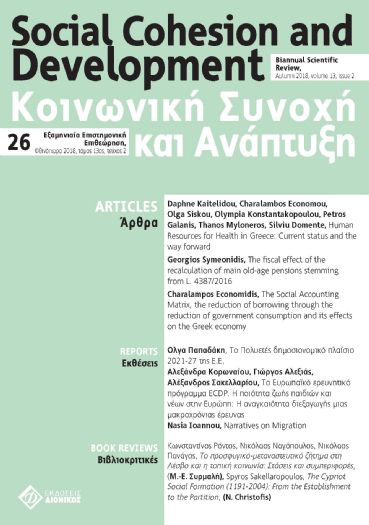Ο Πίνακας Κοινωνικής Λογιστικής, η μείωση του δανεισμού μέσω της μείωσης της κρατικής δαπάνης και η επίδρασή της στην Ελληνική Οικονομία

Δημοσιευμένα:
Jan 19, 2021
Λέξεις-κλειδιά:
Πίνακας Εισροών-Εκροών Ανάλυση Εισροών-Εκροών Κλαδική Ανάλυση και Πίνακας Κοινωνικής Λογιστικής Ελληνική Οικονομία
Περίληψη
Σκοπός της εργασίας είναι να υπολογίσει τις επιπτώσεις στην ελληνική οικονομία που θα επιφέρει η μείωση ή η εξάλειψη του καθαρού δανεισμού. Η υπόθεση που γίνεται για τον υπολογισμό αυτόν είναι ότι η μείωση του καθαρού δανεισμού οδηγεί στην μείωση της κρατικής κατανάλωσης. Ο υπολογισμός των επιπτώσεων στην ελληνική οικονομία από την μείωση του δανεισμού πραγματοποιείται με την χρήση του Πίνακα Κοινωνικής Λογιστικής. Τα αποτελέσματα δείχνουν ότι την μείωση του δανεισμού πρέπει να την αντικαταστήσει σημαντική αύξηση της παραγωγής και ότι οι μειώσεις που προκύπτουν αφορούν κυρίως στους κλάδους στους οποίους το κράτος έχει μεγάλη συμμετοχή, όπως η εκπαίδευση, η υγεία, η ασφάλεια, η δημόσια διοίκηση και η άμυνα.
Λεπτομέρειες άρθρου
- Πώς να δημιουργήσετε Αναφορές
-
Economidis, C. (2021). Ο Πίνακας Κοινωνικής Λογιστικής, η μείωση του δανεισμού μέσω της μείωσης της κρατικής δαπάνης και η επίδρασή της στην Ελληνική Οικονομία. Κοινωνική Συνοχή και Ανάπτυξη, 13(2), 139–158. https://doi.org/10.12681/scad.25847
- Τεύχος
- Τόμ. 13 Αρ. 2 (2018)
- Ενότητα
- Άρθρα

Αυτή η εργασία είναι αδειοδοτημένη υπό το CC Αναφορά Δημιουργού – Μη Εμπορική Χρήση – Παρόμοια Διανομή 4.0.
Οι συγγραφείς των άρθρων που δημοσιεύονται στην Κοινωνική Συνοχή και Ανάπτυξη διατηρούν τα δικαιώματα πνευματικής ιδιοκτησίας επί των άρθρων τους, δίνοντας στο περιοδικό το δικαίωμα της πρώτης δημοσίευσης. Άρθρα που δημοσιεύονται στην Κοινωνική Συνοχή διατίθενται με άδεια Creative Commons 4.0 και σύμφωνα με την άδεια μπορούν να χρησιμοποιούνται ελεύθερα, με αναφορά στο/στη συγγραφέα και στην πρώτη δημοσίευση για μη κερδοσκοπικούς σκοπούς και με δικαίωμα τροποποίησης μόνον με παρόμοια διανομή (αν αναμείξετε, τροποποιήσετε, ή δημιουργήσετε πάνω στο υλικό, πρέπει να διανείμετε τις δικές σας συνεισφορές υπό την ίδια άδεια όπως και το πρωτότυπο).Λήψεις
Τα δεδομένα λήψης δεν είναι ακόμη διαθέσιμα.
Αναφορές
Aray H., Pedauga L. and Velazquez A., (2017), “Financial Social Accounting Matrix: a useful tool for understanding the macro-financial linkages of an economy”, Economic Systems Research, Vol. 29, N. 4, December.
Economides A. and Economidis Ch., (2017), The Social Accounting Matrix as an economic policy tool for addressing the economic crisis, 2nd International Scientific Conference, “Reconstruction in Greece: Economic Crisis and Growth Perspectives”, 5-6 May 2017, Serres, Greece [in Greek].
Economidis Ch. and Economides A., “Using the Social Accounting Matrix to understand the Greek economic crisis”, East-West Journal of Economics & Business (pending publication).
Eurostat (1996), European System of Accounts 1995, Office for Official Publications of the European Communities, Luxembourg.
Miller R. and Blair P., (2009), Input–Output Analysis Foundations and Extensions, Second Edition, Cambridge University Press, Cambridge.
Panethimitakis A., (1991), Greek Manufacture, Sectoral Multipliers of Social Accounting Matrices and Structural path analysis for 1975, Athens University, Centre of Economic Research and Documentation, Gutenberg.
Pyatt G. and Round J., (1979), “Accounting and Fixed Price Multipliers in a Social Accounting Matrix Framework”, The Economic Journal, Vol. 89, No. 356.
Round J., (1988), “Incorporating the International Regional and Spatial Dimension into a SAM: Some Methods and Applications”, in: Harrigan F. J. and McGregor P. G., (eds), Recent Advances in Regional Economic Modeling, London: Pion.
Research Bulletin XB 1027 (1993), SAM Multipliers: Their Decomposition, Interpretation and Relationship to Input-Output Multipliers, Washington State University, College of Agriculture and Home Economics Research Center.
Santos S., (2004), “Portuguese net borrowing and the government budget balance: A SAM approach”, Journal of Policy Modeling, Volume 26, issue 6, September 2004, p.p. 703-717.
Santos S., (2003), Social Accounting Matrices for Portugal in 1998-99. Modeling the effects of changes in government receipts and expenditure, Higher Institute of Economics and Business Administration (Working Paper No 07/2003). Lisbon: Department of Economics, Research Unit on Complexity in Economics.
Sarris A., Zografakis S. and Karfakis P., (2004), Macroeconomic and Redistributional Impacts on the Greek Economy from a Reform of the Tax System: Empirical Analysis with the use of a Multisectoral General Equilibrium Model, Series: Studies, Centre of Planning and Economic
Research (KEPE), No. 54.
Stone R., (1985), “The Disaggregation of the Household sector in the National Account” in: Pyatt G. and Round J., (eds), Social Accounting Matrices. Basis for Planning, Washington, DC: World Bank.
Skountzos T., Touribabas N., Livas P., Mattheos G. and Anastassakou Z, (1985), Social Accounting Matrix for the Greek Economy for Year 1975, Athens: Centre of Planning and Economic Research (KEPE) [in Greek].
Zografakis S. and Spathis P., (2010), The end of fiscal deviations and their implications. Meeting The Greek labor market: features, developments and challenges (2/3/2010). Bank of Greece [in Greek].


